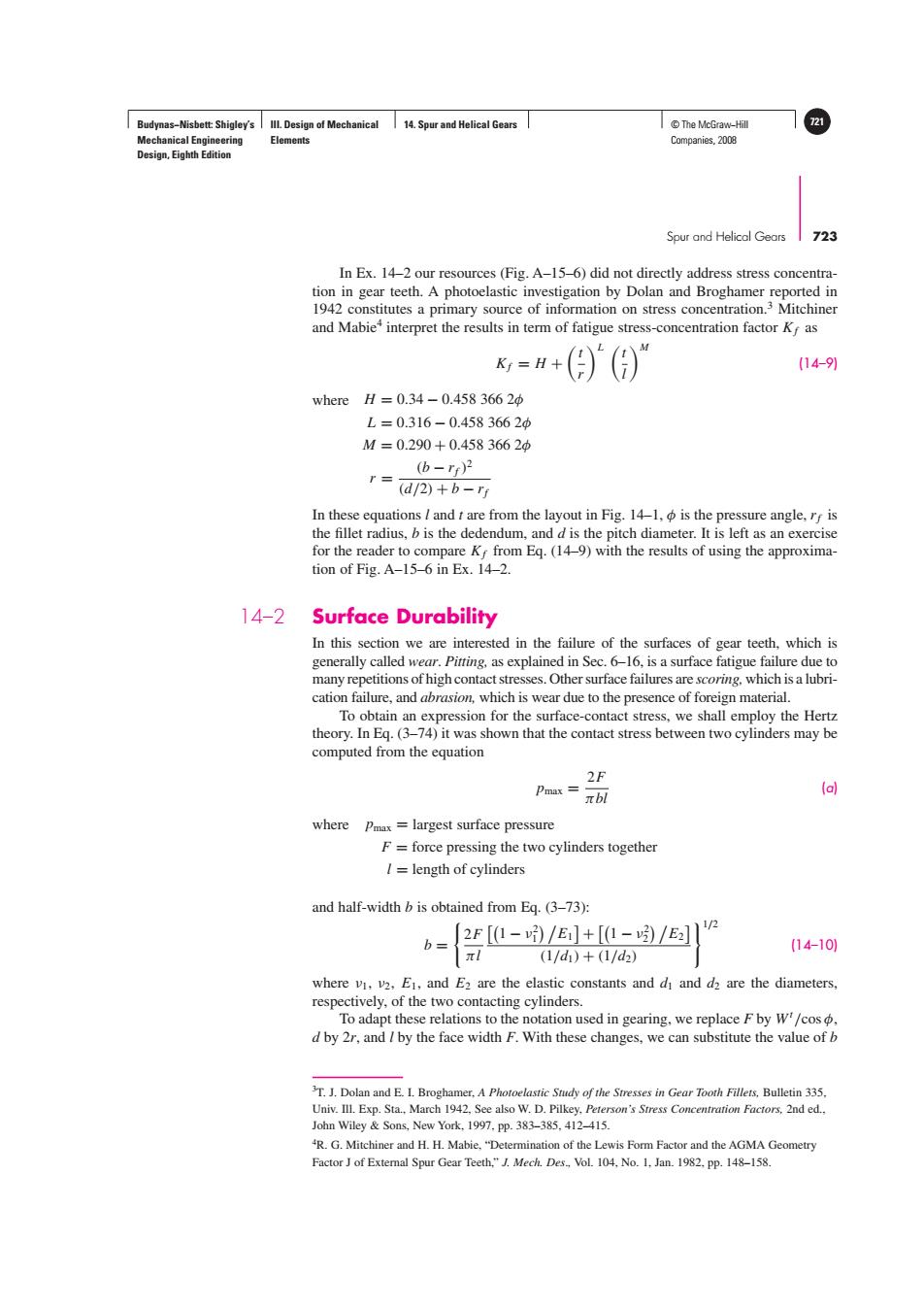正在加载图片...

Budynas-Nisbett:Shigley's Ill.Design of Mechanical 14.Spur and Helical Gears T©The McGraw-Hil 721 Mechanical Engineering Elements Companies,2008 Design,Eighth Edition Spur and Helical Gears 723 In Ex.14-2 our resources (Fig.A-15-6)did not directly address stress concentra- tion in gear teeth.A photoelastic investigation by Dolan and Broghamer reported in 1942 constitutes a primary source of information on stress concentration.3 Mitchiner and Mabie*interpret the results in term of fatigue stress-concentration factor K as Ky=H+ (14-91 where H=0.34-0.4583662φ L=0.316-0.4583662中 M=0.290+0.4583662φ (b-rt)2 (d/2)+b-rr In these equations and t are from the layout in Fig.14-1,is the pressure angle,rf is the fillet radius,b is the dedendum,and d is the pitch diameter.It is left as an exercise for the reader to compare Kr from Eq.(14-9)with the results of using the approxima- tion of Fig.A-15-6 in Ex.14-2. 14-2 Surface Durability In this section we are interested in the failure of the surfaces of gear teeth,which is generally called wear.Pitting.as explained in Sec.6-16,is a surface fatigue failure due to many repetitions of high contact stresses.Other surface failures are scoring.which is a lubri- cation failure,and abrasion,which is wear due to the presence of foreign material. To obtain an expression for the surface-contact stress,we shall employ the Hertz theory.In Eq.(3-74)it was shown that the contact stress between two cylinders may be computed from the equation 2F Pmax (a) πbl where Pmax =largest surface pressure F=force pressing the two cylinders together I=length of cylinders and half-width b is obtained from Eq.(3-73): b= 2F[-/E]+[1-/E]p (14-10) πl (1/d)+(1/d2) where vi,v2,E1,and E2 are the elastic constants and di and d2 are the diameters, respectively,of the two contacting cylinders. To adapt these relations to the notation used in gearing,we replace F by W/cos, d by 2r,and I by the face width F.With these changes,we can substitute the value of b T.J.Dolan and E.I.Broghamer,A Photoelastic Study of the Stresses in Gear Tooth Fillets,Bulletin 335 Univ.Ill.Exp.Sta.,March 1942,See also W.D.Pilkey,Peterson's Stress Concentration Factors,2nd ed. John Wiley Sons,New York,1997.pp.383-385,412-415. 4R.G.Mitchiner and H.H.Mabie."Determination of the Lewis Form Factor and the AGMA Geometry Factor J of Extemal Spur Gear Teeth,"J.Mech.Des.Vol.104,No.1,Jan.1982.pp.148-158.Budynas−Nisbett: Shigley’s Mechanical Engineering Design, Eighth Edition III. Design of Mechanical Elements 14. Spur and Helical Gears © The McGraw−Hill 721 Companies, 2008 Spur and Helical Gears 723 3 T. J. Dolan and E. I. Broghamer, A Photoelastic Study of the Stresses in Gear Tooth Fillets, Bulletin 335, Univ. Ill. Exp. Sta., March 1942, See also W. D. Pilkey, Peterson’s Stress Concentration Factors, 2nd ed., John Wiley & Sons, New York, 1997, pp. 383–385, 412–415. 4 R. G. Mitchiner and H. H. Mabie, “Determination of the Lewis Form Factor and the AGMA Geometry Factor J of External Spur Gear Teeth,” J. Mech. Des., Vol. 104, No. 1, Jan. 1982, pp. 148–158. In Ex. 14–2 our resources (Fig. A–15–6) did not directly address stress concentration in gear teeth. A photoelastic investigation by Dolan and Broghamer reported in 1942 constitutes a primary source of information on stress concentration.3 Mitchiner and Mabie4 interpret the results in term of fatigue stress-concentration factor Kf as Kf = H + t r L t l M (14–9) where H = 0.34 − 0.458 366 2φ L = 0.316 − 0.458 366 2φ M = 0.290 + 0.458 366 2φ r = (b − rf )2 (d/2) + b − rf In these equations l and t are from the layout in Fig. 14–1, φ is the pressure angle, rf is the fillet radius, b is the dedendum, and d is the pitch diameter. It is left as an exercise for the reader to compare Kf from Eq. (14–9) with the results of using the approximation of Fig. A–15–6 in Ex. 14–2. 14–2 Surface Durability In this section we are interested in the failure of the surfaces of gear teeth, which is generally called wear. Pitting, as explained in Sec. 6–16, is a surface fatigue failure due to many repetitions of high contact stresses. Other surface failures are scoring, which is a lubrication failure, and abrasion, which is wear due to the presence of foreign material. To obtain an expression for the surface-contact stress, we shall employ the Hertz theory. In Eq. (3–74) it was shown that the contact stress between two cylinders may be computed from the equation pmax = 2F πbl (a) where pmax = largest surface pressure F = force pressing the two cylinders together l = length of cylinders and half-width b is obtained from Eq. (3–73): b =
2F πl 1 − ν2 1 E1 + 1 − ν2 2 E2 (1/d1) + (1/d2) 1/2 (14–10) where ν1, ν2, E1, and E2 are the elastic constants and d1 and d2 are the diameters, respectively, of the two contacting cylinders. To adapt these relations to the notation used in gearing, we replace F by Wt /cos φ, d by 2r, and l by the face width F. With these changes, we can substitute the value of b����